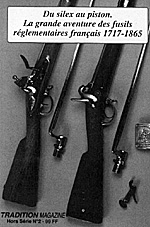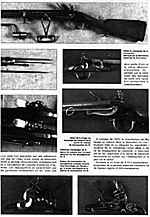 La grande aventure des fusils réglementaires francais 1717-1865
La grande aventure des fusils réglementaires francais 1717-1865
(From flintlock to percussion. The great saga of the regulation French muskets 1717-1865)
Author: Henri Vuillemin
Pages: 98 pages
Illustrations: 288, mostly color photographs showing detailed breakouts
of the weapons, plus period diagrams and numerous charts
Maps: None
Footnotes: None
Appendices: None
Bibliography: 35 French books on muskets, bayonets, and regulations
Index: None
Publisher: This is special issue #2 of Tradition Magazine, published by
L.C.V. Services, 25 rue Bargue 75015 Paris, phone: 33 1 40 61 97 67, fax: 33 1
40 61 96 33
Publication Date: 1997
Binding: Paper (softcover, intended for newsstands)
ISBN: None
Price: 99 FF ($15)
Summary: Du silex au piston is a short but great introduction to the
complex topic of French regulation muskets, including those of the
French Revolution and First Empire. A good portion of the book is
devoted to the Napoleonic period, and it is amply illustrated with fine
color pictures of actual weapons. Some knowledge of French is necessary
in order to utilize the charts, diagrams and captions.
Any collector of antique weapons knows how important good documentation can be. Until the 1960s, this topic received only scant attention. Except for a hard-to-find study done by Captain Bottet in 1900, there was little available to help explain the various weapons which would turn up at auctions.
The breakthrough in information came with the seminal work done by Jean Boudriot, Armes à feu françaises modèles réglementaires (French Firearms, Regulation Models), published privately in four "notebooks". This study covered the topic from the earliest flintlock models (1717) up to the end of World War One. It has already been reprinted twice and is a model of precision and thoroughness. Since its release, other researchers in various articles have supplemented Boudriot's basic work with additional information.
Boudriot's notebooks consist of many exquisite line drawings. Although these are incredibly helpful in identifying a weapon, the illustrations do not provide a "real life" view of what an actual musket looks like.
Apart from going through numerous magazine articles or attending auctions, there was little one could do to become familiar with what a French "Year IX" musket really looks like.
This void has happily been filled by this excellent little booklet from the publishers of Tradition Magazine. This volume is in fact the second of a two- part work; the first dealt with the "bolt-action to World War 2" period and appeared under the guise of another magazine, Gazette des Armes.
Although the weapons surveyed include more than just the Napoleonic period, obviously revolutionary period weapons (including ancien régime muskets) were still in use during the First Empire.
 A book this size is not exhaustive. The topic is huge. (Boudriot covered
just the flintlock period in two massive 200-plus page volumes!) Author
Vuillemin's book is a concise approach and the focus is on the most
widely available and best known weapons. For example, one will find such
staples as the An IX series infantry, dragoon, and navy muskets, and
hussar musketoons — as well as the Imperial Guard An IX muskets and the
beautiful (and scarce) Versailles rifles.
A book this size is not exhaustive. The topic is huge. (Boudriot covered
just the flintlock period in two massive 200-plus page volumes!) Author
Vuillemin's book is a concise approach and the focus is on the most
widely available and best known weapons. For example, one will find such
staples as the An IX series infantry, dragoon, and navy muskets, and
hussar musketoons — as well as the Imperial Guard An IX muskets and the
beautiful (and scarce) Versailles rifles.
Rare types like the Mameluck blunderbuss, the musket of the Guard Grenadiers, and uncommon variations (sometimes field modifications) are not featured. Likewise the special (and extremely rare) 1814 Royal Guard weapons are not to be found. These topics may be covered later in the magazine itself or in some future additional special issue. The best part of this book are the dozens of color close-up photos of the weapons (up to seven a page). In many cases, the muskets have been disassembled to show the various parts. To a collector, this is very valuable stuff. The only thing better is to disassemble an actual weapon yourself to understand what the interior of an 1806-vintage musket is like!
Most of the weapons photographed came from either private collections or from the museum of the fort of Joux in the French Jura mountains. Anyone traveling through the Jura area should make a stop at this little-known but fascinating fort and castle. Its weapons collection is superb. Also of note are the recently re-opened rooms at the French army museum in Paris —- a must-see for anyone seeking this kind of reference material. The biggest drawback to non-French readers is the French text.
Unfortunately, there is very little in the English language that covers this topic in any depth (in fact, there seems to be even less on the subject of British firearms except for Howard Blackmore's recently reprinted study from Greenhill Books).
If the subject interests you, this title is recommended, but purchase a good French-English dictionary at the same time!
More Napoleonic Library
-
Book News 1998
On the Fields of Glory
Les Uniformes des Guerres Napoleoniennes
Les Epogee Napoleonienne
Napoleon
Les Campagne de Russie 1812
Du Silex au Piston
Armes a Feu Francaises Modeles Reglementaires 1717-1836
Back to Table of Contents -- Napoleon #12
Back to Napoleon List of Issues
Back to MagWeb Master Magazine List
© Copyright 1998 by Emperor's Press.
This article appears in MagWeb (Magazine Web) on the Internet World Wide Web.
The full text and graphics from other military history magazines and gaming magazines are available at http://www.magweb.com